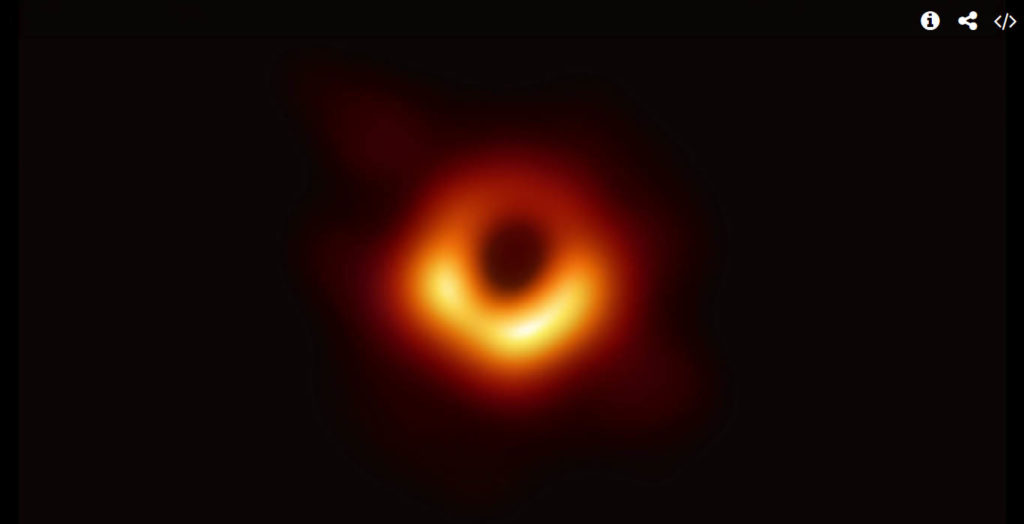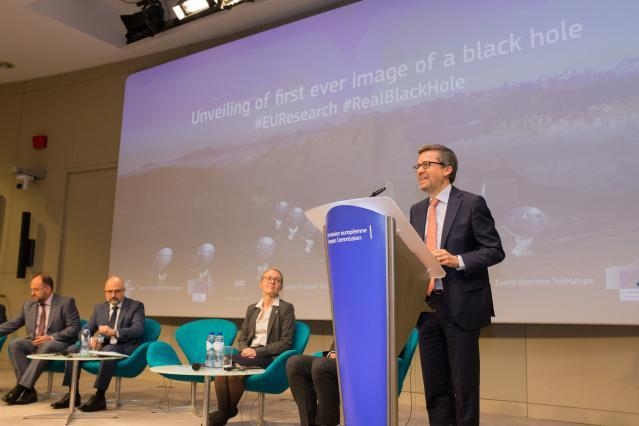The European Commission today released the first ever image of a black hole, captured by the Event Horizon Telescope, a worldwide scientific collaboration in which scientists funded by the European Union participate.
"This first-rate scientific discovery constitutes visual proof of the existence of black holes and expands the frontiers of modern science," the EC said in a statement.
This first-ever observation of a black hole came as part of the large-scale international collaboration designated Event Horizon Telescope (EHT), in which EU-funded researchers have played an important role.
This great scientific achievement marks a paradigm shift in our understanding of black holes, confirms the predictions of Albert Einstein's Theory of General Relativity, and opens up new avenues for studying the Universe.
The first image captured of a black hole was released today at six simultaneous press conferences, held in various parts of the world.
In the words of European Commissioner Carlos Moedas, responsible for Research, Science and Innovation, “fiction often inspires science and black holes have fueled our dreams and our curiosity for a long time. Today, thanks to the contribution of European scientists, the existence of black holes is no longer just a theoretical concept. This extraordinary discovery is once again revealing that collaboration with partners from the four corners of the world can allow us to reach the unattainable and expand the horizons of knowledge».

Professor Jean-Pierre Bourguignon, president of the European Research Council (ERC), added: “I congratulate the scientists who, in various parts of the world, made this inspiring discovery and pushed the frontiers of knowledge forward. I am especially pleased to note the decisive contribution to this discovery by ERC-funded scientists. The EU policy of funding studies with the potential to lead to paradigm shifts in knowledge of the skies has generated yet another success story and re-validates the ERC's objective of funding research projects that associate high risk with the possibility of great results. ».
The initiative Event Horizon Telescope (EHT) received crucial financial support from the EU, through the European Research Council.
Specifically, the EU funded three of the leading scientists who, together with their teams, participated in this discovery and supported the development and improvement of the vast telescope infrastructure essential for the project's success.
The results announced today add to the many achievements of the EU's Horizon 2020 funding programs in the field of research and innovation and the framework programs that preceded them.
Following these successes, the Commission proposed Horizon Europe, the EU's most ambitious program to date to keep the European Union at the forefront of research and innovation worldwide.
Black holes are extremely compressed cosmic objects, made up of an immense mass in a very small space. The presence of a black hole affects the surrounding space-time in an extreme way, deforming it and overheating any matter that precipitates into it.
The captured image shows the black hole at the center of the Messier 87 object, a super galaxy in the constellation Virgo. The identified black hole is located 55 million light years from Earth and its mass is 6500 million times that of the Sun.
To enable direct observation of the space surrounding a black hole, the Event Horizon Europe project sought to improve and network a series of eight telescopes existing in various points on Earth, located at high altitudes in inhospitable places in the Spanish Sierra Nevada, of volcanoes from Hawaii and Mexico, from the mountains of Arizona, from the Atacama Desert in Chile, and from Antarctica.
More than 200 researchers from Europe, the Americas and the Far East participate in this large-scale international operation.
Under the Horizon 2020 program and the EU's 7th Framework Programme, the European Research Council of the European Union funded scientists participating in this collaborative project through the following projects:
O BlackHoleCam project, for 14 million euros, aims to capture images of black holes, take measurements of these cosmic objects and understand them.
This six-year project has been running since 2014 and is the responsibility of three top scientists and their teams, namely Professor Heino Falcke, from Radboud University, in Nimega, Netherlands (also chairman of the Scientific Council of the EHT project), Professor Michael Kramer, from the Max Planck Institute for Radio Astronomy, and Professor Luciano Rezzolla, from the Johann Wolfgang Goethe University in Frankfurt.
O radionet project, which supports a consortium of 27 institutions in Europe, the Republic of Korea and South Africa that aims to integrate world-class infrastructure dedicated to radio astronomy research: radio telescopes, arrays of telescopes, data archives and the European network EVN (European Very Long Baseline Interferometry Network), operating worldwide.
This project is coordinated by the Max Planck Institute for Radio Astronomy. The EU has invested €30,3 million in the RadioNet project over the past 15 years.
The European Research Council, created by the European Union in 2007, is the first European funding organization dedicated to excellent research at the frontiers of knowledge.
Every year, it selects and finances the best and most creative researchers, of any nationality and age, to carry out projects in Europe.
The ERC offers four main grant schemes: Start-Up, Consolidation, Advanced and Synergistic. Along with the additional proof-of-concept scholarship scheme, the ERC helps fellows make the transition between their pioneering research and the early stages of associated commercialization.



















Comments